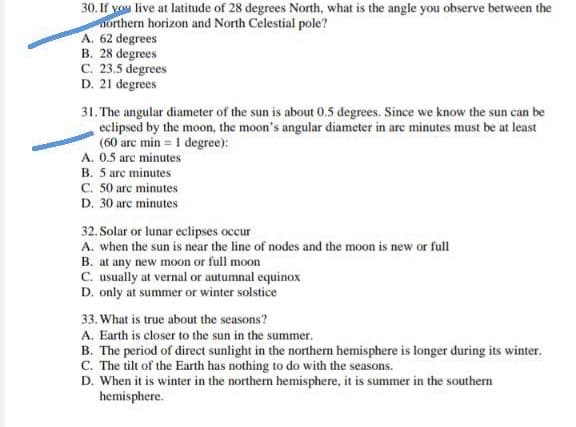30. If you live at latitude morthern horizon and North Celestial pole? A. 62 degrees B. 28 degrees C. 23.5 degrees D. 21 degrees degrees North, what is the angle you observe between the
30. If you live at latitude morthern horizon and North Celestial pole? A. 62 degrees B. 28 degrees C. 23.5 degrees D. 21 degrees degrees North, what is the angle you observe between the
Applications and Investigations in Earth Science (9th Edition)
9th Edition
ISBN:9780134746241
Author:Edward J. Tarbuck, Frederick K. Lutgens, Dennis G. Tasa
Publisher:Edward J. Tarbuck, Frederick K. Lutgens, Dennis G. Tasa
Chapter1: The Study Of Minerals
Section: Chapter Questions
Problem 1LR
Related questions
Question
100%
Please whats the correct options of all parts

Transcribed Image Text:30. If vou live at latitude of 28 degrees North, what is the angle you observe between the
northern horizon and North Celestial pole?
A. 62 degrees
B. 28 degrees
C. 23.5 degrees
D. 21 degrees
31. The angular diameter of the sun is about 0.5 degrees. Since we know the sun can be
eclipsed by the moon, the moon's angular diameter in are minutes must be at least
(60 arc min = 1 degree):
A. 0.5 arc minutes
B. 5 arc minutes
C. 50 arc minutes
D. 30 arc minutes
32. Solar or lunar eclipses occur
A. when the sun is near the line of nodes and the moon is new or full
B. at any new moon or full moon
C. usually at vernal or autumnal equinox
D. only at summer or winter solstice
33. What is true about the seasons?
A. Earth is closer to the sun in the summer.
B. The period of direct sunlight in the northern hemisphere is longer during its winter.
C. The tilt of the Earth has nothing to do with the seasons.
D. When it is winter in the northern hemisphere, it is summer in the southern
hemisphere.
Expert Solution
This question has been solved!
Explore an expertly crafted, step-by-step solution for a thorough understanding of key concepts.
This is a popular solution!
Trending now
This is a popular solution!
Step by step
Solved in 2 steps

Recommended textbooks for you

Applications and Investigations in Earth Science …
Earth Science
ISBN:
9780134746241
Author:
Edward J. Tarbuck, Frederick K. Lutgens, Dennis G. Tasa
Publisher:
PEARSON

Exercises for Weather & Climate (9th Edition)
Earth Science
ISBN:
9780134041360
Author:
Greg Carbone
Publisher:
PEARSON

Environmental Science
Earth Science
ISBN:
9781260153125
Author:
William P Cunningham Prof., Mary Ann Cunningham Professor
Publisher:
McGraw-Hill Education

Applications and Investigations in Earth Science …
Earth Science
ISBN:
9780134746241
Author:
Edward J. Tarbuck, Frederick K. Lutgens, Dennis G. Tasa
Publisher:
PEARSON

Exercises for Weather & Climate (9th Edition)
Earth Science
ISBN:
9780134041360
Author:
Greg Carbone
Publisher:
PEARSON

Environmental Science
Earth Science
ISBN:
9781260153125
Author:
William P Cunningham Prof., Mary Ann Cunningham Professor
Publisher:
McGraw-Hill Education

Earth Science (15th Edition)
Earth Science
ISBN:
9780134543536
Author:
Edward J. Tarbuck, Frederick K. Lutgens, Dennis G. Tasa
Publisher:
PEARSON

Environmental Science (MindTap Course List)
Earth Science
ISBN:
9781337569613
Author:
G. Tyler Miller, Scott Spoolman
Publisher:
Cengage Learning

Physical Geology
Earth Science
ISBN:
9781259916823
Author:
Plummer, Charles C., CARLSON, Diane H., Hammersley, Lisa
Publisher:
Mcgraw-hill Education,